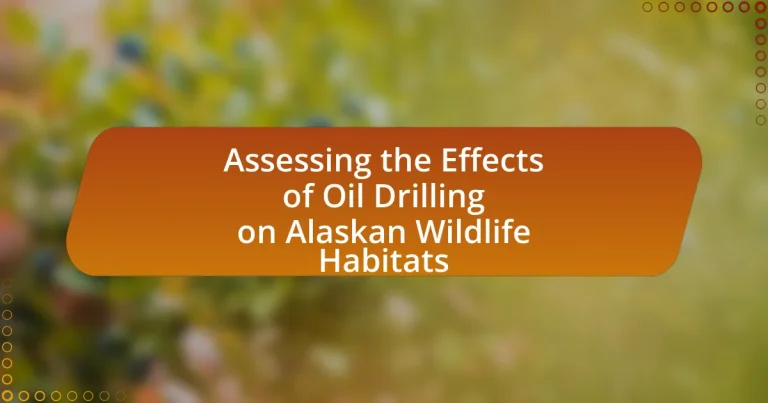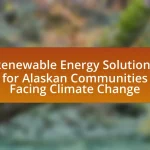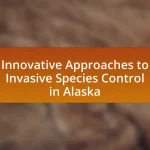The article focuses on the effects of oil drilling on Alaskan wildlife habitats, highlighting significant disruptions caused by habitat fragmentation, pollution, and increased human activity. It details how oil drilling adversely affects species such as polar bears and caribou, leading to stress, reduced populations, and altered migration patterns. The article also examines the consequences of oil spills, the regulatory measures in place to assess environmental impacts, and the role of technology and community engagement in mitigating ecological damage. Furthermore, it discusses best practices for balancing oil extraction with wildlife conservation efforts in sensitive ecosystems.
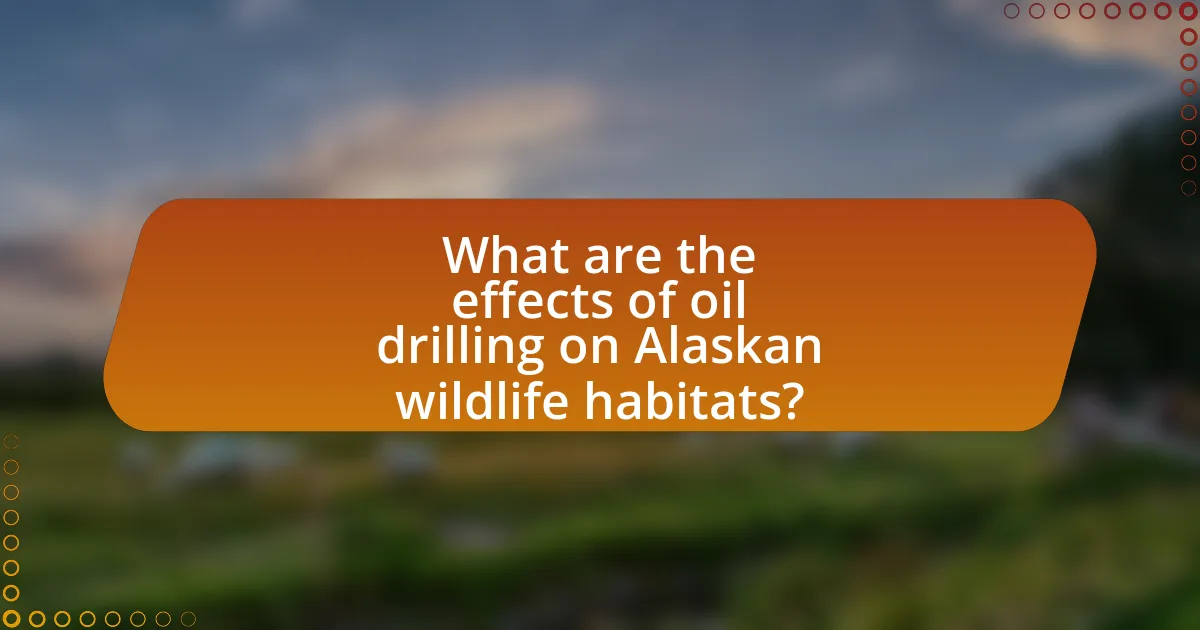
What are the effects of oil drilling on Alaskan wildlife habitats?
Oil drilling significantly disrupts Alaskan wildlife habitats by causing habitat fragmentation, pollution, and increased human activity. Habitat fragmentation occurs as drilling infrastructure, such as roads and pipelines, divides ecosystems, making it difficult for species to migrate and find food. Pollution from oil spills and emissions contaminates air and water, adversely affecting the health of wildlife and their food sources. Additionally, increased human activity associated with drilling leads to disturbances in animal behavior, particularly during critical breeding and feeding periods. Studies have shown that species such as caribou and polar bears experience stress and reduced populations in areas impacted by oil drilling, highlighting the detrimental effects on biodiversity in these habitats.
How does oil drilling impact the ecosystem in Alaska?
Oil drilling significantly impacts the ecosystem in Alaska by disrupting wildlife habitats and contributing to pollution. The extraction process leads to habitat fragmentation, which affects species such as caribou and migratory birds that rely on these areas for breeding and feeding. Additionally, oil spills pose a severe threat to marine and terrestrial ecosystems, as evidenced by the 1989 Exxon Valdez oil spill, which resulted in long-term ecological damage and loss of biodiversity in Prince William Sound. Studies indicate that oil drilling activities can lead to increased noise pollution, which disrupts animal communication and mating behaviors, further endangering species.
What specific wildlife species are affected by oil drilling activities?
Oil drilling activities specifically affect species such as polar bears, caribou, and various migratory birds in Alaska. Polar bears are impacted due to habitat loss and decreased sea ice, which is critical for their hunting and breeding. Caribou populations face disruptions in their migration patterns and calving grounds due to drilling infrastructure and increased human activity. Additionally, migratory birds, including species like the Arctic tern and various shorebirds, experience habitat degradation and disturbances during nesting seasons, which can lead to decreased reproductive success. These effects are documented in studies highlighting the ecological consequences of oil extraction in sensitive Arctic environments.
How do oil spills influence the health of wildlife habitats?
Oil spills severely degrade the health of wildlife habitats by contaminating soil and water, leading to toxic environments for flora and fauna. The presence of hydrocarbons in oil disrupts the biological processes of organisms, causing immediate harm and long-term ecological damage. For instance, studies have shown that oil spills can lead to decreased reproductive success in birds and marine mammals, as well as increased mortality rates among fish and invertebrates. The Exxon Valdez oil spill in 1989 resulted in significant declines in local fish populations and long-lasting impacts on the reproductive health of seabirds in Prince William Sound, demonstrating the profound and lasting effects of oil contamination on wildlife habitats.
What are the short-term and long-term effects of oil drilling?
The short-term effects of oil drilling include habitat disruption, increased noise pollution, and potential oil spills, which can lead to immediate harm to wildlife and ecosystems. For instance, during drilling operations, heavy machinery and human activity can disturb local fauna, causing stress and displacement. Long-term effects encompass habitat degradation, chronic pollution, and altered species dynamics, which can result in decreased biodiversity. Research indicates that oil drilling in sensitive areas like Alaska can lead to lasting changes in wildlife populations and ecosystem health, as seen in studies conducted by the U.S. Geological Survey, which highlight the long-term impacts on species such as caribou and migratory birds due to habitat fragmentation and pollution.
How does oil drilling affect animal migration patterns?
Oil drilling disrupts animal migration patterns primarily through habitat fragmentation and increased human activity. The construction of drilling sites, roads, and pipelines alters the landscape, making it difficult for animals to navigate their traditional migratory routes. For instance, studies have shown that caribou herds in Alaska have changed their migration paths due to oil development, leading to decreased access to calving grounds and increased stress on populations. Additionally, noise pollution from drilling operations can interfere with the communication and mating behaviors of species such as migratory birds, further impacting their migration patterns.
What are the consequences of habitat fragmentation due to drilling?
Habitat fragmentation due to drilling leads to significant ecological consequences, including loss of biodiversity and disruption of wildlife movement. When drilling occurs, it creates physical barriers that isolate animal populations, making it difficult for species to migrate, find mates, and access resources. Studies indicate that fragmented habitats can reduce species richness by up to 50%, as seen in various ecosystems impacted by oil extraction activities. Additionally, the alteration of habitats can lead to increased edge effects, which expose species to higher predation rates and invasive species, further threatening native wildlife.
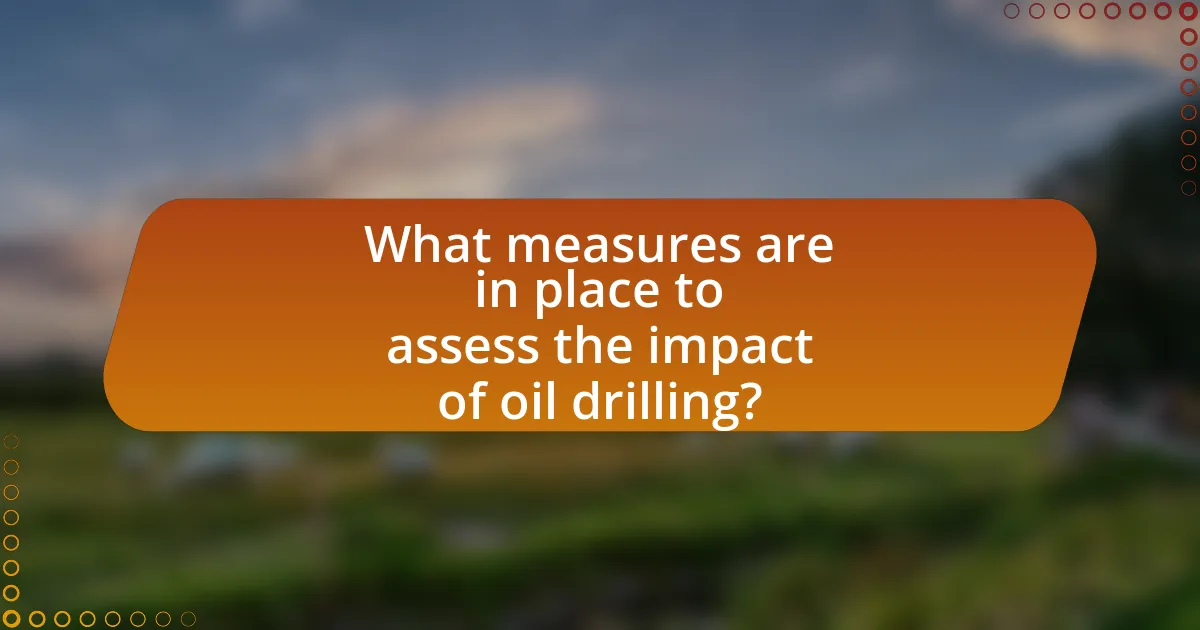
What measures are in place to assess the impact of oil drilling?
Measures in place to assess the impact of oil drilling include environmental impact assessments (EIAs), continuous monitoring programs, and regulatory frameworks established by agencies such as the Environmental Protection Agency (EPA) and the Bureau of Land Management (BLM). EIAs evaluate potential environmental effects before drilling begins, while monitoring programs track changes in wildlife populations, habitat conditions, and water quality during and after drilling activities. Regulatory frameworks enforce compliance with environmental standards and require mitigation strategies to minimize adverse effects. These measures are supported by scientific studies, such as those conducted by the U.S. Geological Survey, which provide data on the ecological consequences of oil drilling in sensitive areas like Alaskan wildlife habitats.
How are environmental assessments conducted in Alaska?
Environmental assessments in Alaska are conducted through a systematic process that evaluates the potential impacts of proposed projects on the environment. This process typically involves the preparation of an Environmental Impact Statement (EIS) or Environmental Assessment (EA), which includes public participation, data collection, and analysis of environmental factors such as wildlife habitats, air and water quality, and cultural resources. The National Environmental Policy Act (NEPA) mandates these assessments for federal actions, ensuring that decision-makers consider environmental consequences before proceeding with projects like oil drilling. Additionally, state regulations and local guidelines may further shape the assessment process, requiring collaboration with various stakeholders, including indigenous communities and environmental organizations, to address specific ecological concerns.
What methodologies are used to evaluate wildlife populations?
Methodologies used to evaluate wildlife populations include direct observation, population modeling, and remote sensing. Direct observation involves counting individuals or assessing signs of presence in a specific area, which provides immediate data on population size and distribution. Population modeling uses statistical techniques to estimate population dynamics based on collected data, allowing for predictions about future trends and impacts. Remote sensing employs satellite imagery and aerial surveys to gather data over large areas, facilitating the assessment of habitat changes and population distributions. These methodologies are essential for understanding the effects of environmental changes, such as oil drilling, on wildlife habitats in Alaska.
How do researchers monitor habitat changes over time?
Researchers monitor habitat changes over time using a combination of remote sensing, field surveys, and ecological modeling. Remote sensing technologies, such as satellite imagery and aerial photography, allow researchers to detect changes in land cover and vegetation patterns over large areas. Field surveys provide ground-truthing data, enabling researchers to assess species diversity, population dynamics, and habitat quality directly. Ecological modeling helps predict future habitat changes based on current data and environmental variables. These methods collectively provide a comprehensive understanding of habitat alterations, particularly in sensitive areas like Alaskan wildlife habitats affected by oil drilling.
What regulations govern oil drilling in sensitive wildlife areas?
Regulations governing oil drilling in sensitive wildlife areas include the National Environmental Policy Act (NEPA), the Endangered Species Act (ESA), and the Migratory Bird Treaty Act (MBTA). NEPA requires federal agencies to assess the environmental impacts of proposed projects, including oil drilling, ensuring that potential effects on wildlife habitats are considered. The ESA protects endangered and threatened species and their habitats, mandating that drilling activities do not jeopardize these species. The MBTA prohibits the take of migratory birds, which can be affected by oil drilling operations. These regulations collectively aim to minimize the ecological impact of oil drilling in sensitive wildlife areas, particularly in regions like Alaska, where unique ecosystems are at risk.
What role do government agencies play in wildlife protection?
Government agencies play a crucial role in wildlife protection by establishing regulations, enforcing laws, and managing conservation efforts. These agencies, such as the U.S. Fish and Wildlife Service and state wildlife departments, implement policies that protect endangered species and their habitats, conduct research to monitor wildlife populations, and oversee land management practices. For instance, the Endangered Species Act, enacted in 1973, empowers these agencies to designate critical habitats and develop recovery plans for threatened species, demonstrating their authority and responsibility in safeguarding biodiversity.
How effective are current regulations in mitigating environmental damage?
Current regulations are moderately effective in mitigating environmental damage from oil drilling in Alaskan wildlife habitats. The implementation of the National Environmental Policy Act (NEPA) requires environmental assessments for drilling projects, which helps identify potential impacts on ecosystems. Additionally, the Oil Pollution Act mandates contingency planning for oil spills, aiming to minimize ecological harm. However, studies indicate that enforcement challenges and loopholes often undermine these regulations, leading to incidents that still threaten wildlife. For instance, a report by the U.S. Government Accountability Office highlighted that regulatory oversight is inconsistent, resulting in inadequate protection for sensitive habitats.

What are the potential solutions to minimize the impact of oil drilling?
To minimize the impact of oil drilling, implementing advanced technologies such as directional drilling and hydraulic fracturing can significantly reduce surface disruption. Directional drilling allows for accessing oil reserves from a single location, minimizing the number of drilling sites needed, while hydraulic fracturing enhances extraction efficiency. Additionally, establishing strict regulatory frameworks that enforce environmental assessments and monitoring can help mitigate ecological damage. For instance, the National Environmental Policy Act mandates environmental reviews for federal projects, ensuring that potential impacts on wildlife habitats are considered. Furthermore, investing in renewable energy alternatives can decrease reliance on oil drilling, thereby reducing its overall environmental footprint.
How can technology reduce the ecological footprint of drilling?
Technology can reduce the ecological footprint of drilling by implementing advanced techniques such as precision drilling, real-time monitoring, and automated systems. Precision drilling minimizes the area disturbed by drilling activities, thereby preserving surrounding ecosystems. Real-time monitoring technologies, including satellite imaging and sensors, allow for immediate detection of environmental impacts, enabling swift mitigation measures. Automated systems enhance efficiency and reduce human error, leading to less waste and lower emissions. For instance, the use of directional drilling can access multiple oil reserves from a single site, significantly decreasing land use and habitat disruption. These technological advancements collectively contribute to a more sustainable approach to drilling, aligning with environmental conservation efforts.
What innovations are being developed to protect wildlife habitats?
Innovations being developed to protect wildlife habitats include advanced monitoring technologies, habitat restoration techniques, and sustainable land-use planning. Advanced monitoring technologies, such as satellite imagery and drone surveillance, enable real-time tracking of wildlife movements and habitat changes, allowing for timely conservation interventions. Habitat restoration techniques, including reforestation and wetland restoration, aim to rehabilitate degraded ecosystems, thereby enhancing biodiversity. Sustainable land-use planning incorporates ecological considerations into development projects, minimizing habitat fragmentation and preserving critical wildlife corridors. These innovations are essential in mitigating the adverse effects of oil drilling and other industrial activities on Alaskan wildlife habitats.
How can best practices in drilling operations enhance habitat conservation?
Best practices in drilling operations can enhance habitat conservation by minimizing environmental impact and promoting sustainable resource extraction. Implementing techniques such as directional drilling reduces surface disturbance, allowing for smaller drilling footprints and preserving surrounding ecosystems. Additionally, using advanced technologies for monitoring and managing waste can prevent contamination of soil and water resources, which is crucial for maintaining the health of wildlife habitats. Research indicates that companies adopting these practices can significantly lower their ecological footprint, thereby supporting the conservation of biodiversity in sensitive areas like Alaskan wildlife habitats.
What role can local communities play in wildlife protection?
Local communities play a crucial role in wildlife protection by actively participating in conservation efforts and advocating for sustainable practices. These communities often possess traditional ecological knowledge that enhances conservation strategies, allowing for more effective management of local wildlife habitats. For instance, in Alaska, Indigenous communities have been instrumental in monitoring wildlife populations and habitats, leading to better-informed decisions regarding oil drilling impacts. Their involvement has been shown to improve biodiversity outcomes, as evidenced by collaborative projects that integrate local insights with scientific research, ultimately fostering a more sustainable approach to wildlife protection amidst industrial activities.
How can community engagement improve conservation efforts?
Community engagement can significantly improve conservation efforts by fostering local stewardship and increasing awareness of environmental issues. When communities actively participate in conservation initiatives, they are more likely to take ownership of local ecosystems, leading to better protection and management of wildlife habitats. For instance, studies have shown that community-led conservation projects in Alaska have resulted in enhanced monitoring of wildlife populations and habitats, as local residents possess valuable knowledge about their environment. Additionally, engaging communities in decision-making processes can lead to more culturally relevant and effective conservation strategies, as seen in the collaborative efforts between indigenous groups and conservation organizations in Alaska, which have successfully addressed the impacts of oil drilling on wildlife habitats.
What initiatives exist to involve local stakeholders in decision-making?
Initiatives to involve local stakeholders in decision-making regarding oil drilling in Alaskan wildlife habitats include community advisory boards, public consultation meetings, and collaborative management agreements. Community advisory boards facilitate ongoing dialogue between stakeholders, including local residents, environmental groups, and industry representatives, ensuring that diverse perspectives are considered in the decision-making process. Public consultation meetings allow stakeholders to voice their concerns and provide input on proposed drilling projects, fostering transparency and accountability. Collaborative management agreements, often established between government agencies and local communities, create frameworks for shared decision-making, enabling stakeholders to actively participate in the management of natural resources and the protection of wildlife habitats. These initiatives are essential for balancing economic development with environmental conservation in Alaska.
What are the best practices for balancing oil drilling and wildlife conservation?
The best practices for balancing oil drilling and wildlife conservation include implementing strict regulatory frameworks, conducting comprehensive environmental impact assessments, and utilizing advanced technology to minimize habitat disruption. Regulatory frameworks, such as the National Environmental Policy Act, ensure that oil drilling projects undergo thorough scrutiny to assess their potential effects on wildlife habitats. Comprehensive environmental impact assessments provide data on how drilling activities may affect local ecosystems, allowing for informed decision-making. Additionally, employing technology like directional drilling and remote monitoring can significantly reduce the physical footprint of drilling operations, thereby protecting sensitive wildlife areas. These practices are supported by studies indicating that well-regulated drilling can coexist with wildlife conservation efforts, as seen in regions where adaptive management strategies have been successfully implemented.
